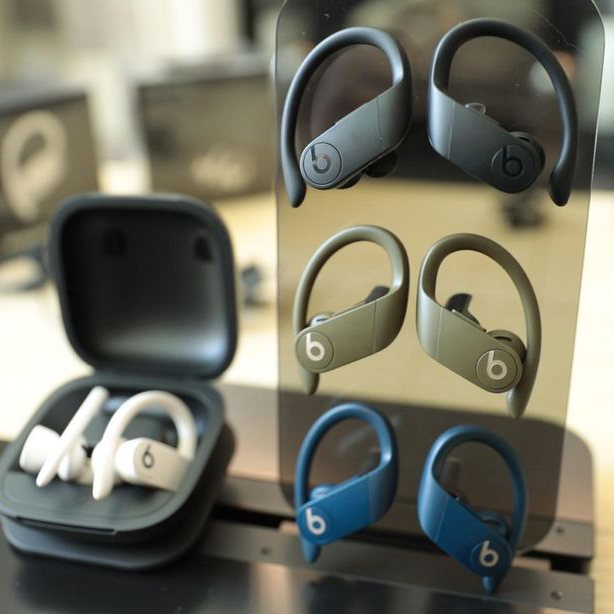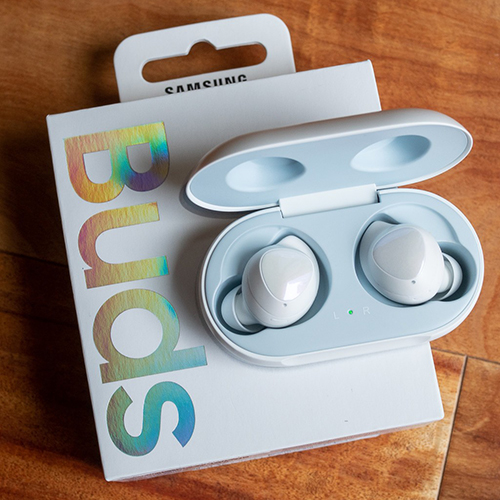Hearables Q1 2019 Recap
As we enter into the second quarter of 2019, it’s worth looking back on all the news surrounding hearables during the first quarter of the year. Things are really starting to heat up as each of the major smart assistant providers begin to bring its AirPods rival to market and attempt to poach some of the “ear share” away from Apple.
According to Voicebot’s 2018 Consumer Adoption Report, AirPods comprise 24.1% of the true-wireless earbud market, while Apple-owned Beats makes up 11.8%, giving Apple a grand total of 35.9% of the wireless “ear-share.” AirPods and Beats currently represent Apple’s best area to succeed with its overall voice strategy, as AirPods have a whopping 98% customer satisfaction score, while HomePod’s recent price drop signals that the far-field strategy isn’t fairing as well.
Apple’s Auditory Focus
 Apple appears intent on keeping its lead in the wireless earbud market, with the introduction of a new version of AirPods in March and the PowerBeats Pro the first week of April. The new version of AirPods is an incremental upgrade, offering slightly better battery life, “hey Siri” invocation, lower latency, faster pairing, Bluetooth 5.0 compatibility and a wireless charging case. The PowerBeats Pro are Beat’s first foray into truly wireless earbuds, as previous versions of Beats were tethered with a cable from one earbud to the other. The PowerBeats Pro come in four different color schemes, have much of the same upgrades featured in the new AirPods (albeit no wireless charging case), and are advertised as having superior noise isolation for background sounds.
Apple appears intent on keeping its lead in the wireless earbud market, with the introduction of a new version of AirPods in March and the PowerBeats Pro the first week of April. The new version of AirPods is an incremental upgrade, offering slightly better battery life, “hey Siri” invocation, lower latency, faster pairing, Bluetooth 5.0 compatibility and a wireless charging case. The PowerBeats Pro are Beat’s first foray into truly wireless earbuds, as previous versions of Beats were tethered with a cable from one earbud to the other. The PowerBeats Pro come in four different color schemes, have much of the same upgrades featured in the new AirPods (albeit no wireless charging case), and are advertised as having superior noise isolation for background sounds.
An interesting aspect to both of these new product announcements is the change that Apple made to the chipset powering the devices. Apple had previously been using the W-series chip in its Apple Watches, AirPods, Beats Solo3, Powerbeats3, and BeatsX. Both the new version of AirPods and the PowerBeats Pro will use Apple’s new H-1 chip, which is specifically designed for hearables and is responsible for all the improvements in the AirPods device performance, as well as the “Hey Siri” hands-free activation. The fact that Apple has dedicated a specific chip architecture to its line of in-the-ear devices should serve as evidence to the importance of AirPods and Beats to Apple’s overall strategy.
New Entrants in the Near-Field
 The question I posed in the first column I wrote for Voicebot this year was, “How will the other smart assistant providers look to compete with Apple’s AirPods?” It did not take long for the answer to that question to begin emerging as Samsung entered into the near-field arena with the introduction of its Galaxy Buds in February. The company also announced at its Galaxy S10 launch event that customers who preordered the S10 would get a complementary pair of Samsung’s new wireless earbuds.
The question I posed in the first column I wrote for Voicebot this year was, “How will the other smart assistant providers look to compete with Apple’s AirPods?” It did not take long for the answer to that question to begin emerging as Samsung entered into the near-field arena with the introduction of its Galaxy Buds in February. The company also announced at its Galaxy S10 launch event that customers who preordered the S10 would get a complementary pair of Samsung’s new wireless earbuds.
The Galaxy Buds do appear to be a solid competitor to AirPods as they offer the same type of super-fast pairing and access to Bixby or Google assistant via a side button. One of the starkest differences in features is around wireless charging. The new version of AirPods that were recently released do feature wireless charging, however, users will need to use a third-party wireless charging pad as Apple shut down the project for its own forthcoming charging pad, AirPower. Compare this to the fact that you can charge the Galaxy Buds on the back of the Galaxy S10 itself, allowing the Buds to siphon battery from the phone. Samsung’s battery capabilities and prowess seem to outweigh that of Apple’s.
Perhaps the biggest challenge to AirPods, however, will come from Amazon. Bloomberg reported last week that Amazon is due to release its first, ear-worn, Alexa-embedded wearable device in the second half of 2019. Amazon’s hearable is being developed inside its Lab126 hardware division, which employs a number of former Doppler Labs employees. Doppler was a pioneer in the hearables space, bringing one of the first products to market, the Here One, that gave the market a glimpse into what an “ear-computer” might function and look like. Doppler eventually went bankrupt after running into production issues with its second-generation device the Here Two. It will be interesting to see how the Doppler Lab’s vision of hearables manifests itself with Amazon’s impending ear-worn device.
Amazon’s major obstacle with moving Alexa to the near-field is its lack of a smartphone. Unlike Google, Samsung and Apple, which all have handsets, Amazon’s failed Fire Phone leaves it beholden and reliant on the smartphone manufacturer each Alexa user is using. Up until this point, Amazon has extended Alexa outside of its smart speakers through third party hardware integrations and app-installs on iOS and Android devices. Until Amazon’s wearables are standalone devices with cellular connections built-in and can connect to Alexa independent of a phone, it appears Amazon will have to depend on its rivals to provide access to its smart assistant via a smartphone tethered to its hearable. Regardless, once Amazon has released its hearable to the market, all four of the major smart assistant providers, Amazon, Google, Apple and Samsung, will have a proprietary hardware offering that puts its smart assistants right in our ears.
Out with the Old, in with the New
While we’ve seen new entrants enter into the hearables field this year, old hardware players have also fallen by the wayside. The most notable was Bragi, which announced that it would be shutting down its Dash hardware line last week. Back before AirPods debuted in December 2016, the concept of a hearable was being shaped by startups like Bragi, Doppler and Nuheara, and the devices that each were bringing to market were far more sophisticated than AirPods. Bragi’s Dash Pro was loaded with cool features, ranging from live-language translation, smart assistant integration to augmented audio and biometric monitoring.
It appears in hindsight that both Bragi and Doppler were too ambitious early on, putting too much emphasis on edge features and not enough emphasis on the core aspects that made the more simplistic AirPods such a hit, namely, super-fast pairing, solid connectivity and sufficient battery life. Unlike Doppler however, Bragi is not dead, but rather pivoting away from hardware toward licensing its NanoAI machine learning software. Although we will no longer see product from these early trailblazers, we still may see Bragi and Doppler continue to impact the future of hearables through any future NanoAI integrations or as former employees move on to help shape product at one of the tech titans.
Aural Real-Estate for Sale
We entered into 2019 with Apple owning the ear, relative to the other smart assistant providers, with Google’s lackluster Pixel Buds as the only challenger to AirPods. Now that we’re approaching an era where all four of the major smart assistant providers will have its own ear-worn device to house its smart assistant, Apple’s somewhat uncontested lead will begin to be tested. As the competition for our “ear-share” intensifies, the ultimate winner will likely be the consumer, as they’ll reap the windfall of innovation that will likely stem from each of the tech titans trying to outdo each other and make the case for why their hearable deserves our aural real-estate.
Follow @Oaktree_Dave Follow @voicebotai
Hearing Aids as a Home for Smart Assistants – The Hearables Market Expands









